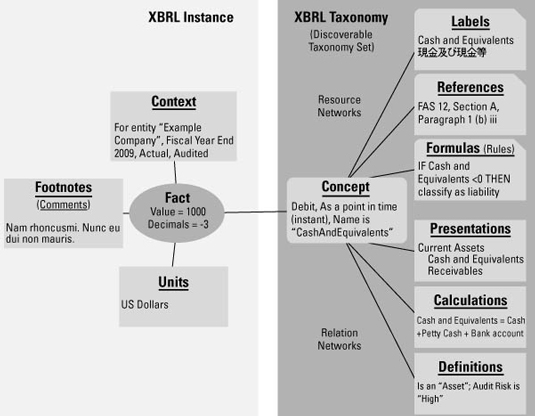The following figure illustrates the high-level logical components of XBRL. The XBRL Specification defines these high-level logical components and the physical means by which to express them. The following table provides a brief description of each high-level component.

| Component | Description |
|---|---|
| XBRL Instance | Basically, a new type of XML business report format that contains business information. XBRL instances contain facts being reported and other information (such as context and units) that provides context for those facts. May also contain footnotes (comments). XBRL instances refer to XBRL taxonomies that describe the facts used within that XBRL instance. |
| Context | Provides context for facts, including information about the entity, the period, or other dimensions of the reported information. |
| Units | Provides additional context needed for numeric facts, such as the currency of the fact or some other unit of measure. |
| Fact | Information being reported or exchanged. A fact has a value, is associated with a concept from an XBRL taxonomy, and has contextual information associated with it. Facts can also have footnotes associated with them. |
| Footnotes | Basically comments that can provide additional information relating to a fact or that can connect facts together. |
| Discoverable Taxonomy Set | Collection of all XBRL taxonomies referred to by either an XBRL instance or by an XBRL taxonomy. |
| XBRL Taxonomy | Similar to a dictionary that describes information contained within an XBRL instance. However, unlike a dictionary, XBRL taxonomies can also express other information, such as hierarchies of relations between those dictionary entries. |
| Concept | Used by facts in an XBRL instance. Concepts describe facts and have specific and unique meanings, names, data types, and other attributes. A concept specifies the XML tag and other constraints on a fact in an XBRL instance. Concepts are similar to the words in a dictionary. |
| Network | A set of related concepts or resources. You can use networks to organize an XBRL taxonomy and to express multiple sets of relations or resources. |
| Resource Network | A set of related resources. Resources provide additional information about a concept. |
| Labels | Allow the taxonomy creator to create labels for each concept in the taxonomy. They let humans work with a more user-friendly label rather than having to work with ugly XML element names. Labels also provide multilingual and multidialect support. Labels also provide documentation for a concept, such as a human-readable definition of the concept. |
| References | Allow the taxonomy creator to express references to external sources (such as a paragraph in a manual) that explain or further define a concept in human terms. References are pointers to a reference, not the references themselves. |
| Formulas | Allow the taxonomy creator to express various types of business rules to be enforced. XBRL instances that use an XBRL taxonomy containing these rules must comply to these rules. |
| Relations Networks | A set of related concepts. Relation networks allow taxonomy creators to associate one concept with another concept in various ways for many purposes. |
| Presentation | Allow for a simple parent-child type of relationship (a hierarchy) to be expressed. Presentation relations are primarily intended to help organize the XBRL taxonomy. You can also use presentation-type relations to help generate human-readable renderings of an XBRL instance. |
| Calculation | Allow for certain types of computations to be expressed between concepts within an XBRL taxonomy. Only addition and subtraction are handled by XBRL calculation relations. You can use XBRL Formulas to express more sophisticated computations. |
| Definition | Can be used for any number of purposes. Definition relations basically let you express any type of relation, and you can define any role that explains what type of relation you have created. |
dummies
Source:http://www.dummies.com/how-to/content/highlevel-components-of-xbrl-and-their-definitions.html
No comments:
Post a Comment